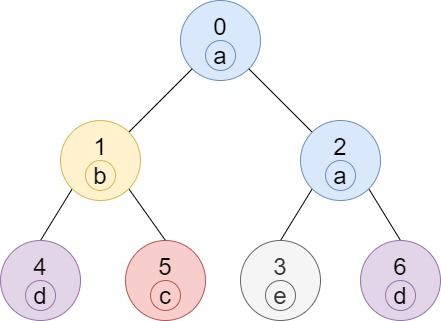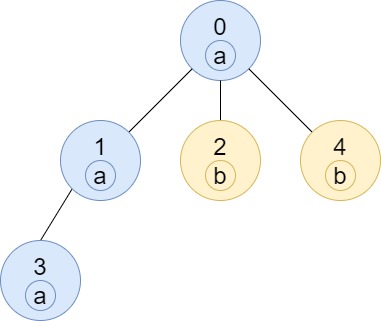[1/12] 1519. Number of Nodes in the Sub-Tree With the Same Label
본문
1519. Number of Nodes in the Sub-Tree With the Same Label
You are given a tree (i.e. a connected, undirected graph that has no cycles) consisting of n nodes numbered from 0 to n - 1 and exactly n - 1 edges. The root of the tree is the node 0, and each node of the tree has a label which is a lower-case character given in the string labels (i.e. The node with the number i has the label labels[i]).
The edges array is given on the form edges[i] = [ai, bi], which means there is an edge between nodes ai and bi in the tree.
Return an array of size n where ans[i] is the number of nodes in the subtree of the ith node which have the same label as node i.
A subtree of a tree T is the tree consisting of a node in T and all of its descendant nodes.
Example 1:

Input: n = 7, edges = [[0,1],[0,2],[1,4],[1,5],[2,3],[2,6]], labels = "abaedcd" Output: [2,1,1,1,1,1,1] Explanation: Node 0 has label 'a' and its sub-tree has node 2 with label 'a' as well, thus the answer is 2. Notice that any node is part of its sub-tree. Node 1 has a label 'b'. The sub-tree of node 1 contains nodes 1,4 and 5, as nodes 4 and 5 have different labels than node 1, the answer is just 1 (the node itself).
Example 2:

Input: n = 4, edges = [[0,1],[1,2],[0,3]], labels = "bbbb" Output: [4,2,1,1] Explanation: The sub-tree of node 2 contains only node 2, so the answer is 1. The sub-tree of node 3 contains only node 3, so the answer is 1. The sub-tree of node 1 contains nodes 1 and 2, both have label 'b', thus the answer is 2. The sub-tree of node 0 contains nodes 0, 1, 2 and 3, all with label 'b', thus the answer is 4.
Example 3:

Input: n = 5, edges = [[0,1],[0,2],[1,3],[0,4]], labels = "aabab" Output: [3,2,1,1,1]
Constraints:
1 <= n <= 105edges.length == n - 1edges[i].length == 20 <= ai, bi < nai != bilabels.length == nlabelsis consisting of only of lowercase English letters.
관련자료
-
링크
학부유학생님의 댓글
- 익명
- 작성일
from collections import Counter, defaultdict
class Solution:
def countSubTrees(self, n: int, edges: List[List[int]], labels: str) -> List[int]:
graph = defaultdict(list)
for e1, e2 in edges:
graph[e1].append(e2)
graph[e2].append(e1)
res = [0]*n
def dfs(prev, curr):
counter = Counter()
for nxt in graph[curr]:
if nxt == prev: continue
counter = counter + dfs(curr, nxt)
counter[labels[curr]] += 1
res[curr] = counter[labels[curr]]
return counter
dfs(-1, 0)
return res









